CancerMate: a revolutionary tool for personalized and precision monitoring of breast cancer neoadjuvant therapy
CancerMate is a software application designed for the optimization of clinical care of solid tumor. The focus is to quantify lesion volumes (in the sense of the macroscopic scale of the disease) after therapy – even before the patient undergoes to it. The simulated (in-silico) volumetric lesions are analogous to volumetric lesions or metabolic tumor volumes undergoing proliferation, when assessed with diagnostic imaging evaluations (in-vivo).
The present Mark I version has been validated against clinical data of treatment-naïve patients with locally advanced non-metastatic triple negative breast cancer, treated with neodjuvant Lynparza. Now, the trained model can attack the prognosis of prospective patients.
The validation and the biomarkers employed thereof, have been documented in Schettini, F. et al. (2023). Computational reactive–diffusive modeling for stratification and prognosis determination of patients with breast cancer receiving Olaparib. Scientific Reports, 13(1), 11951.
In its MVP form, CancerMate is a working tool for virtual human twinning (VHT) in oncology.
Two more studies are underway on retrospective patient cohorts, to create personalized avatars on HER2-positive patients:
Mark II is focusing on new functionals for the pharmacodynamics of a two-stage therapy – namely, standard EC followed by a combination of Paclitaxel and Herceptin. In particular, the second therapy stage has been found depending on a Microbiota Diversity Index, determined by a personalized combination of Simpson’s Diversity Index, and Firmicutes and Bacteroidetes concentrations (collaboration: IRCCS Istituto Nazionale dei Tumori Foundation, Milan, Italy);
Mark III is focusing on the outcome of the dimensional lesion, when an one-shot Herceptin is administrered (collaboration: Multidisciplinary Unit of Breast Pathology and Translational Research, Cremona Hospital, Cremona, Italy).
Such predictive modeling approach may have transformative implications for breast cancer oncology: we pave the way for an innovative strategy that harnesses the predictive power of oncology mathematics to optimize therapeutic interventions, ultimately advancing the frontier of personalized oncology care.



